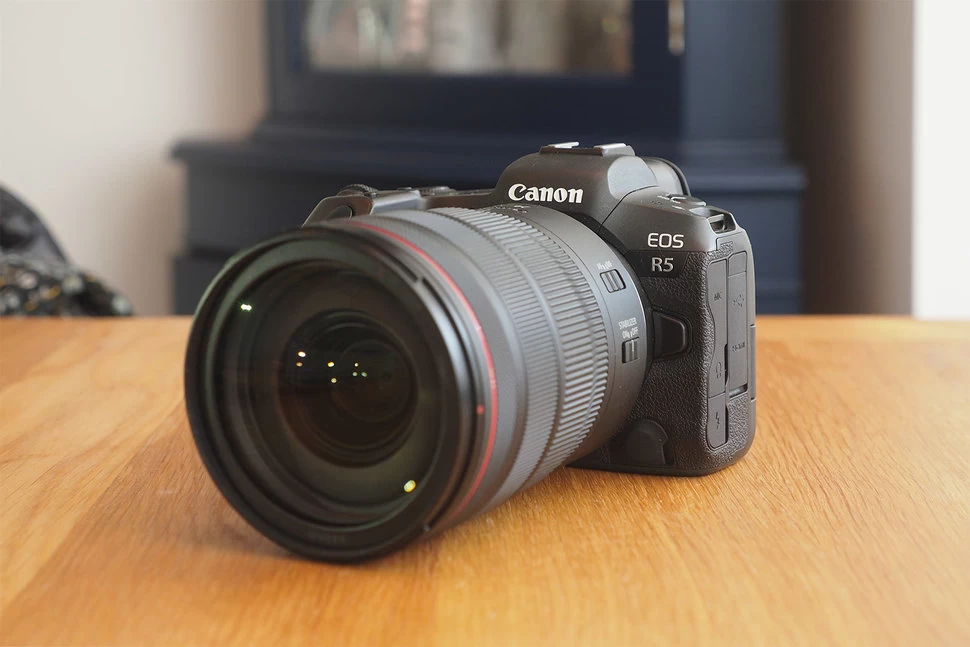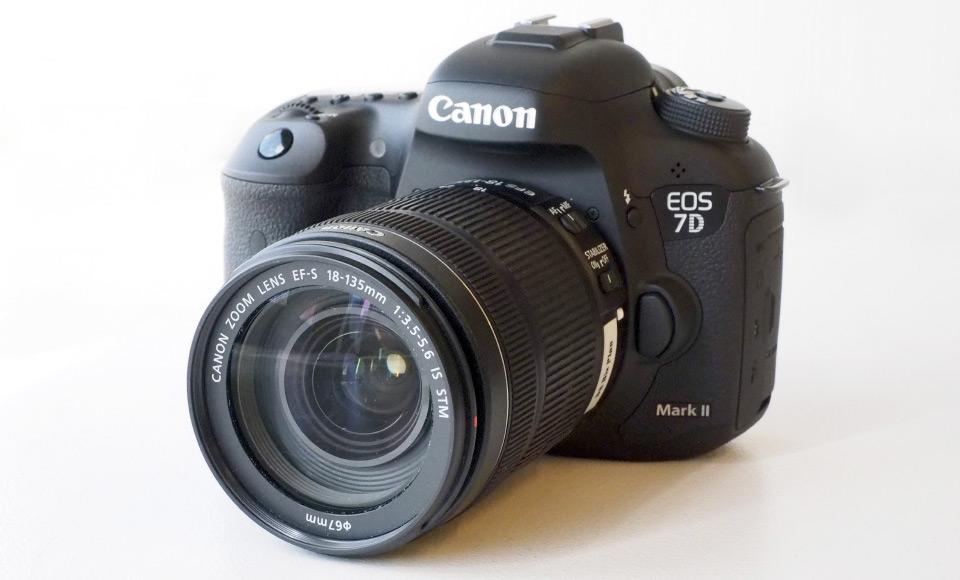This full-frame mirrorless camera is an absolute powerhouse, offering top-notch image quality, autofocus, and in-body stabilization performance. There are some issues with high-end video overheating, the body-only price is high, and the competition from Sony is strong. All in all, though, the R5 is the model of choice in this lineup, improves on the company’s outgoing DSLR series, and shows that you’re in very safe hands indeed.
Read conclusion
Pros
- Superior autofocus modes – human/animal tracking is impressive
- Mechanical burst at 12 frames per second
- Super-detailed 45-megapixel images
- In-body image stabilization is excellent
Cons
- Overheating in high-end video modes – limits in-camera recording time
- Easy to shift focus point by accidentally touching the screen
- It is obviously expensive
- CFexpress card adds to the cost
With the camera market shrinking in recent years, how can brands revive and entice customers? Well, Canon has a pretty good idea: throw everything, including the kitchen sink, into spec and watch them flock.
That’s pretty much the idea behind the EOS R5: a mirrorless camera packed to the gills that not only touts a 45-megapixel full-frame sensor-which means it can also shoot 4K and 8K video-but also an in-body stabilization system, super autofocus system, and a top-end viewfinder.
It pretty much has it all – including a massive asking price. Perhaps that’s why less flocking than Canon would like is coming. But for those looking for a versatile mirrorless camera for professionals, the EOS R5 – as a sort of spiritual successor to the EOS 5D Mark IV – is an absolute powerhouse.
Design & Lens Mount
- OLED electronic viewfinder (EVF) with a resolution of 5.76 m pixels, 120 fps refresh rate
- 3.2-inch LCD touchscreen with 2.1m pixel resolution
- Canon RF bayonet (EF & EF-S via adapter – sold separately)
- Body dimensions: 138.5 x 97.5 x 88 mm / Weight: 738 g
- Dual card slots (1x CFexpress, 1x SD)
- Weatherproof design
The EOS R range is now full-featured, with multiple options within the range – there’s the EOS R, RP, R6, R3 – showing Canon’s commitment to its mirrorless future. In fact, older EF lenses, like the ones you’d use on Canon’s DSLR lineup, are being phased out one by one, paving the way for the future of the RF bayonet – the very fit you’ll find on the front of the EOS R5. Fortunately, you can also use EF and EF-S lenses via an adapter (sold separately) if you have some great old glass you want to keep using.

Looking at the EOS R5 is very Canon and very traditional. If you’ve used Canon DSLR cameras over the years, you’ll feel instantly familiar as the buttons are placed in familiar places for ease of use. It’s a bit different, of course, since it’s mirrorless and the touchscreen controls and screen-based use are a bit more defining here.
The screen swivels, which is handy for positioning it flat for shooting at waist height or overhead work, or even flipping it over completely – which can make some video shooting easier depending on the situation. It’s a good quality screen that responds to touch to the extent that we accidentally moved the autofocus area often and rather annoyingly. However, we very much like the fact that it can be tucked inside against the body so that it doesn’t get scratched.
Above the screen is an electronic viewfinder with some of the highest quality specs you’ll find in any EVF. It’s large to the eye, and even though it’s a digital OLED display, it has a fast refresh rate option (up to 120Hz) that really helps eliminate some of the motion “judder” that some EVFs can suffer. This comes at a bit more of a cost in battery life, but it’s worth it for the overall more traditional feel of use in our opinion.

On the side of the camera is the card slot, which opens easily to reveal slots for SD and CFexpress. The latter, while extremely fast and therefore useful for full-resolution continuous shooting and high-end video recording, is also extremely expensive – so don’t forget to consider a card purchase and card reader if it’s the slot you’re interested in taking advantage of.
Performance
- Autofocus: Dual Pixel CMOS AF II
- Face & Tracking, Single Point, Multi Point, various zone systems
- 1053-area with automatic selection, 5940 points with manual selection
- Continuous shooting at 12 frames per second (20 frames per second electronic shutter)
- 350 JPEG / 180 Raw file buffer
- In-body image stabilization system (IBIS)
- Functions down to -6EV in low light conditions
- 320 shots per battery
It’s almost hard to know where to start with the EOS R5’s capabilities. It’s probably best summed up: This is a super-fast, super-capable camera that doesn’t put a foot wrong in any respect.

Starting with the autofocus system, which is available in a whole range of modes: Face Detection + Tracking, Spot, 1-Point, Expand Area, Expand Area: Ambient, Zone, Large Zone Vertical, Large Zone Horizontal. These cover all eventualities, from pinpoint focus in a specific selected area to wide-open zones/areas where autofocus can better handle moving objects through a scene.
Of the many, however, the Face Detection + Tracking option is the most impressive. It has a whole host of features quietly built-in, from human head tracking to animal and bird detection, that can really help you get a sharp shot every time without having to manually adjust settings.

Furthermore, the autofocus system works very well in low-light conditions, as we found out one evening while shooting at five-digit high ISO in a dimly lit pub. It detects contrast differences down to -6EV, so there doesn’t have to be more than candlelight for focus to be plausible. Impressive.
Then there’s the in-body stabilization system, a rarity among Canon EOS cameras. In fact, the R5 is the first with this system, along with the R6. Canon says it can last up to eight stops depending on the lens used, which is a huge assist against handshake. This can make all the difference in getting a particularly sharp shot, which is especially important with such a high scale and resolution full-frame sensor.
If you need to shoot moving subjects at high speed, this is not a problem for this system. There’s also a 12fps continuous shooting mode, which increases to 20fps when using the electronic shutter version. This is super fast, on a professional level, and ensures that nothing goes wrong.

However, if you use all of this intensively, the battery life wears off pretty quickly. We took around 280 shots before it was time to go, luckily it’s easy to take spares with you and the dedicated battery compartment on the bottom of the camera is easily accessible.
Image quality
- 45-megapixel full-frame sensor, Digic-X processor
- 8K 12-bit raw video (24/25/30fps)
- 4K/120fps video (4:2:2 10-bit)
- ISO 100-51,200 sensitivity
Replacing our everyday camera with the EOS R5 made a difference in the images we took – most of which were product photography for Pocket-lint reviews.

The first advantage of the R5 is its full-frame sensor. Its large scale really helps improve background blur, while the f/2.8 lens we used also provides better control of depth of field here. With melting backgrounds in the shots, their appearance is really improved.
Then there’s resolution and the resulting detail. Canon isn’t messing around when it comes to this brand new sensor, that’s for sure. There are 45 megapixels to play with – about twice that of the EOS R6 – and it offers tremendous scaling that can be easily changed or cropped without having to worry much about limitations.
Resolution aside, it’s the clarity that’s particularly phenomenal, with even higher ISO sensitivity selections proving just how adept the stabilization system and overall image processing are. Handheld shots at ISO 12,800, for example, look anything but – most of the noise is held back, delivering only subtle grain when you look up close.



If anything, this is Canon’s best sensor for handling resolution, resolving detail, and offers a wide dynamic range. So if you’re thinking about upgrading from another Canon camera, the R5 won’t let you down – especially if you have the better RF lenses.
From stills to video, the R5 is also really adept at capturing moving images. The ability to shoot 4K at 120fps or 8K at 24/25/30fps is impressive – but don’t let the numbers knock your socks off just yet, as there are overheating issues when saving to a card in the camera that will limit some of these upper-resolution options.

If you thought that the threshold of 29 min again). So if you want to see the R5 as a professional video camera rig, you really need some extra kit to record off-camera.
First impressions
So does throwing everything and the kitchen sink at the specs work? By and large, yes, because the Canon EOS R5 is an absolute powerhouse that is impressive in terms of image quality, autofocus, stabilization, and overall speed. The swivel screen and top-drawer electronic viewfinder are also great.
Because of this performance, however, there are some issues: The 4K and 8K video recording modes, while clearly impressive from a technical standpoint, will lead to overheating issues if you want to shoot long scenes on the cards in the camera. The body-only price is also much higher than the lower-resolution EOS R6, mostly due to the 45-megapixel sensor here. Oh, and the battery life isn’t particularly amazing either.
All in all, though, the Canon EOS R5 is a huge step forward for the R-series and cements the full-frame RF-mount camera as the first choice in this lineup. And as Canon’s DSLR lineup sails quietly into the night, it’s great to see better-than-equal products emerging in this newer mirrorless market. You’re in safe hands folks, Canon absolutely knows what it’s doing – but so does Sony, so if you’re not steadfast in brand loyalty, you can’t ignore the competition either.






